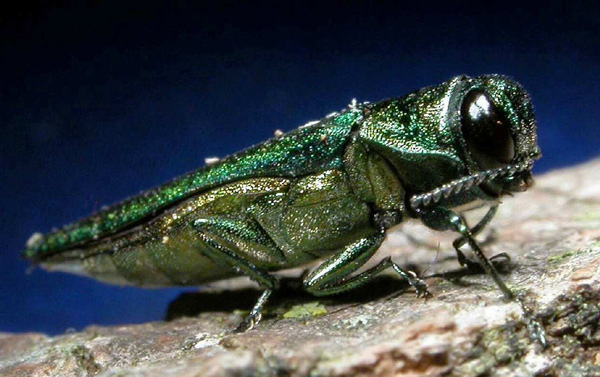An invasion of emerald ash borers has arrived Attacks always fatal

By Hugh Earnhart
OSU Ext. master gardener volunteer
“Now hear this”!
When I was in the Navy, the utterance of these words meant you needed to pay attention because it might affect you.
“Now hear this” is now appropriate for all of us. Nature is being invaded by a green, metallic-looking, wood-boring beetle called the emerald ash borer (Agrilus planipennis) (EAB). This insect has a massive appetite for ash trees.
The Ohio Department of National Resources estimates that 3.8 billion Ohio ash trees will be destroyed by the EAB invasion. The insect has established itself in our area. Most homeowners in Poland and other communities of the Mahoning Valley are noticing this pest because of dead and dying trees in their yards and neighborhoods.
This exotic insect is native to Eastern Asia. It was first discovered in the summer of 2001 in Southeastern Michigan ash trees, probably brought here in wooden shipping material bound for Detroit.
The adult, wood-boring beetle is dark metallic green, a half-inch in length, and flies from early May until September. As adult borers emerge from trees, they leave distinct D-shaped exit holes in the bark of the tree. Adult borers mate and the female produces about 50-100 eggs. These eggs are laid on crevices, cracks, or splits in the tree’s bark.
When the larvae develop, they bore into the tree and spend the summer and early fall months feeding on the phloem and sapwood, leaving noticeable S-shaped tunnels under the bark.
Pupation occurs in spring, and adults come forth, completing a typical one-year cycle.
Like the chestnut blight of the 1940s, and the Dutch elm disease in the 1970s, the EAB infestation has the potential of destroying the entire ash tree population in both the rural forest and trees in urban areas and parks. It’s a serious environmental threat to our landscape. To date, it is estimated that some 30 million ash trees have been killed in 15 states and Canada. All 88 counties in Ohio are under quarantine status because of the spread of the EAB epidemic.
Scientifically speaking, entomologists are under-the-gun. They are studying the EAB to learn more about its biology and behavior patterns. To date the EAB has attacked only the green, black, blue, pumpkin, and white ash trees. The mountain ash is not a true member of the ash family.
The adult EAB has good flying ability up to about a half-mile. They may even be hitch-hiking on modern transportation and by the movement of lumber and firewood products.
They have no known predators, but woodpeckers will lunch on them during winter months. Once the EAB infects the tree, it is always fatal and the tree will start to die from the top down.
Depending on the severity of the infestation and the original health of the tree, the ash will usually be dead in a period of three to six years. Predictions of ash mortality in infested areas suggests that forest managers plan and budget for hazard tree removal, restoration projects, and pre-emptive harvest.
If you have ash trees on your property, now is the time to examine them for EAB damage. The following are signs and symptoms to look for:
SIGN AND SYMPTOMS
D-shaped emergence holes in the bark. These holes are very distinct. If not D-shaped, you have native borers.
S-shaped tunneling just behind the bark. If the bark is loose, pull it back to look for the serpentine tunnels. If packed with fine frass (sawdust and excrement), it’s a sure sign of infestation. Look for legless, white, flat and heavy segmented larvae about one inch in length.
EAB larvae have bell-shaped segments and are found just behind the bark. They resemble small tapeworms.
An ash tree with a thinning canopy or dying from the top down most likely has EAB. But be careful – there are other ash diseases affecting trees as well.
Vertical splits in the bark measuring 2 to 5 inches long may be where eggs have hatched.
Unnatural sprouting from the main tree trunk or the tree base. The tree knows it is in trouble and is trying to save itself by sprouting new life.
Uncommon woodpecker activity on a living ash tree. The bird is looking for the larvae.
The ash borer quarantine of a specific area needs to be taken seriously if we are to slow down the expansion of the EAB. Any individual who is apprehended transporting ash trees, parts of ash trees, or all hardwood firewood from any restricted county is subject to severe penalties. Violators face fines of up to $4,000. The EAB has been reported in every surrounding state, most of our region and into Canada.
Trees are important to our economy, the aesthetics of our natural environment and our good health. Understand the signs of this pest in your neighborhood and try to deal with the effects on our local trees.
To learn more about this invasive bug, how to deal with infestations and how to save a tree (using chemicals), visit http://ashalert.osu.edu.
 43
43

